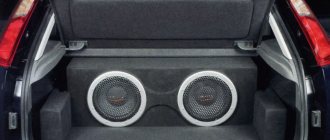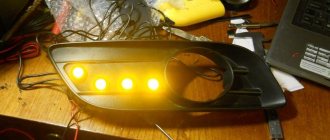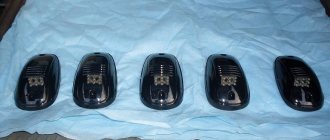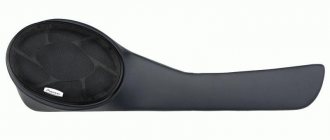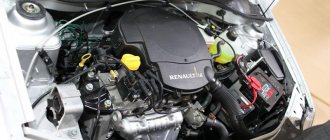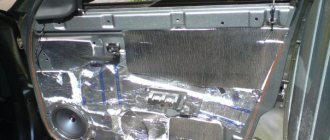As you know, a subwoofer in a car is an integral element for obtaining high-quality, rich and powerful sound. Moreover, in addition to the speaker for the subwoofer, the most important part is the box for the subwoofer.
The sound quality, volume, as well as the ability of the subwoofer to fully “open up”, etc. will depend on the box. In this article we will look at what to pay attention to when designing, as well as how to make a subwoofer box yourself.
Types of subwoofers
When figuring out how to make a subwoofer, it is necessary to evaluate the properties of the main types of these devices. The user can choose among the following varieties:
- Active subwoofer.
- Passive type models.
Active designs are available with an amplifier and crossover, which guarantees good sound with suppression of the high-frequency range. Such models can work with any sources.
Samples of the second group are not equipped with amplification units, and are connected to the standard radio. The disadvantage of a passive device is that the channels are fully loaded, which degrades the quality of the reproduced sound.
Depending on the design features, the following types of boxes are distinguished: open and closed boxes (CL). The former are built into the finishing elements of the interior, and the latter are made in the form of independent boxes, inside of which a speaker with a low-frequency range is installed.
Subwoofer box 10
A closed box for a 10-inch subwoofer with your own hands can be easily made from multi-layer plywood or MDF. The simplest design is made from rectangular parts. In some models, the front and rear walls are installed at an angle, and the finished structure has a trapezoid shape. A closed box for a 10-inch subwoofer must be completely sealed, so after assembling the speaker, all internal seams are coated with silicone sealant. The closed-type design does not require adjustment, while more complex systems with bass reflexes have to be adjusted.
What to make from
To make a subwoofer with your own hands, it is important to take care of the materials for its creation. First of all, you should prepare the following:
- Speakers. When choosing a speaker, you should evaluate its technical parameters: they must correspond to the capabilities of the car radio. If a new part is purchased, then all the characteristics will be indicated on the packaging or in the package insert.
- MDF sheets. Enclosures for subwoofers are also made from plywood, chipboard and fiberboard. The type of material is selected taking into account the dimensions of the future structure.
- Acoustic cable.
- Sealing compound or PVA glue.
- Fastening elements. They use self-tapping screws, since nails are prohibited for such work.
- Epoxy resin.
- Paint and varnish product.
Which speaker to choose
To make a subwoofer from a regular speaker, you need to take a number of parameters into account, since they affect the size of the future speaker box. Often, inexperienced drivers make a mistake and choose a device based on power. However, these values only indicate the load capacity that the speaker can handle for an hour or a few seconds. Therefore, a powerful device does not guarantee good and clear sound.
When choosing a product, you first need to evaluate the properties of the diffuser. To get less distortion at peak volume, it is better to use large designs with a small amplitude of vibration.
Since the diffuser is subject to increased air resistance, the material from which it is made must be strong and reliable. Paper products are only suitable for “sound-in” speakers. Models based on polypropylene are sensitive to temperature changes and have minimal rigidity, which is why they are used in budget car acoustics. The best solution is considered to be carbon fiber and Kevlar.
As for metal acoustic systems, they provide precise sound production with intense resonance. However, these features only appeal to some users.
When choosing a speaker, its sensitivity is also taken into account. The characteristics can be assessed by the dimensions and power of the magnetic element.
You should also pay attention to the resonance frequency.
Subwoofer box drawings
In this article we will make a box for a subwoofer with a 12-inch speaker. The recommended box volume for one 10-12 inch speaker is 40-50 liters. Calculating a box for a subwoofer is not difficult, here is an approximate diagram with the dimensions of the panels.
It is worth paying attention to the minimum distance from the walls of the case to the speaker. It, like the volume of the entire box, is calculated based on the inner surface.
How to calculate a box
The calculation of the box is made using ready-made algorithms or from scratch. There are a lot of calculators on the Internet that allow you to make an accurate calculation for the case, determine what volume the box is needed and what the optimal dimensions are. To eliminate deviations, you need to take into account a number of rules.
First, let's calculate the volume of the subwoofer. For two speakers with a diagonal of 15 inches, it is better to calculate a 60-liter box, and for 12 inches, a 45-liter box. The optimal height is h=340 mm=34 cm=0.34 m, and the permissible length L=680 mm=68 cm=0.68 m. 1 liter = 1•10−3 m³ 1 l = 0.001 m³ then V= 45 l = 0.0 4 m³.
If the body will be located in the wing niche and have a complex geometric design, it is necessary to calculate the body for all parts, separating the volumes of both sides.
How to assemble a subwoofer
After preparing all the tools and materials, work on the construction of the structure can begin. Making a box for a 12-inch subwoofer with a diameter of 30 cm is quite simple. First of all, you should make a hole for the future speaker, maintaining a distance of 20 cm from the center to the walls.
Next you need to follow the following instructions:
- We are preparing the main elements of the future homemade building. Their parameters are calculated in advance on a trusted resource with online calculators.
- We make a hole in the front of the plywood sheet or MDF, chipboard.
- We cut a slot above the hole for the bass reflex tube and screw the compartment.
- We glue the side elements with PVA glue and fasten them with self-tapping screws. It is important to tighten the fasteners all the way, as any voids will negatively affect the sound quality.
- We cut out places for the wires at the back of the case.
- Before connecting all the components, we place the speaker in the box.
- The final stage involves finishing the interior space. Joints and crevices should be sealed with caulk or epoxy to improve sealing.
- External finishing consists of covering the body with carapet fabric. The carapet is stretched and secured with epoxy or a furniture stapler.
After completion of all stages, final assembly is carried out with connection to the standard car radio.
Since the closed bass reflex box (FI) is large in size, car owners prefer to install a compact “Stealth” subwoofer made by themselves. The mini model provides clear sound over a wide range of frequencies and takes up less space in the car.
In most cases, the box for the 10th subwoofer is placed in the trunk, but some people practice mounting it in the fender or spare tire niche.
The optimal volume for uninterrupted and high-quality operation of the device is 18 liters if 12-inch subs are used.
To properly make a box for a subwoofer, you can consider a simplified option by creating a closed box. It is created according to the same principles as the bass reflex model, but without making a gap. The ZYA has a hole for the speaker, so its design looks quite simple.
All kinds of bandpasses represent a full-fledged bass reflex, but in a modified format. Therefore, assembling a homemade sub is quite simple.
The most complex design is considered to be a subwoofer in the form of a horn. Due to the complexity of manufacturing, novice craftsmen abandon this option, preferring more simplified models. However, the horn is distinguished by volumetric lows and provides deep sound at all frequencies. But any deviation from the drawings will make all efforts useless, because... The sub won't sound right.
Therefore, experts recommend choosing the option of a closed box or bass reflex box for the subwoofer. The bandpass is also characterized by its simple design.
When assembling a box for a subwoofer, it is important to follow all safety rules and be careful. The work involves the use of piercing and cutting objects, as well as electric tools. The use of faulty devices is prohibited.
Box for subwoofer 12 inches drawing
The design of the box for a 12 subwoofer depends on the design of the sound system. When using speakers of a smaller diameter, it is not always possible to implement a bass reflex design, while a 12-inch speaker is suitable for this. How to calculate a box for a 12-inch subwoofer with a bass reflex.
The bass reflex can be slotted, as shown in the drawing, or in the form of a pipe. The first design is practically not adjustable, so after the subwoofer is manufactured it will be difficult to change its acoustic characteristics. In household acoustic speakers, the flow and efficiency of the air flow can be adjusted by placing pieces of foam rubber in the acoustic box. This is more difficult to do with subwoofers. The dimensions of a 12-inch subwoofer in centimeters are indicated in the drawing and are determined by the characteristics of the loudspeaker used, therefore most bass reflex box circuits are designed for a specific speaker model. The main element of the bass reflex in a subwoofer is the port. This is the part of the structure in which the phase of the audio signal is rotated. The quality of the entire sound system depends on the accurate calculation of the port.
How to install a subwoofer
Installing a subwoofer box in a car with your own hands is not a difficult task. However, for successful installation you need to have some skills and tools. In addition to placing the subwoofer and amplifier, you should take care of the following related devices:
- Circuit breakers.
- Wiring.
- Capacitors.
- Plastic clamps.
- Spanners.
- Electrical tape and wire cutters.
After choosing the optimal location for installing the subwoofer, you need to make sure that it can cope with resonances from the device. It is not allowed to place the box on fragile machine structures.
The wires are connected according to the following diagram:
- First you need to connect the cable to the amplifier.
- Next, the amplification unit is connected to the car radio.
- A cable with a positive value is wrapped in corrugation to protect it from deformation.
- The fuse is fixed on the same wire, maintaining a minimum distance between the batteries.
Before starting a homemade sub, it is important to check whether the battery is disconnected. This rule will allow you to protect yourself from electric shock and avoid damage to the radio.
Assembling the box for the subwoofer
You can start assembling. We use a 12 inch speaker.
Its diameter is 30 cm, and the first thing you need to do is cut a hole for the speaker. The minimum distance from the center of the diffuser to the subwoofer wall is 20 cm. We measured 23 cm (20 cm + 3 cm plywood width) from the edge of the panel and cut a hole with a jigsaw. Next, we cut a hole for the bass reflex slot; in our example, it has a size of 35*5 cm.
Instead of a slot, you can use a classic air duct - a tube. Now we assemble the bass reflex slot and attach it to the front panel of the subwoofer. We go along the joints with liquid nails and tighten them with self-tapping screws.
It is important to tighten the screws very tightly so as not to leave voids. They will create resonant vibrations that will ruin the sound of the subwoofer.
Next, we assemble the side walls of the box, having previously lubricated them with liquid nails, and tighten them tightly with self-tapping screws.
On the back cover of the box you need to cut a small hole for the terminal block. We connect all parts of the body. We make sure that we cut and fastened all the parts correctly.
We insert the speaker. Let's look and admire.
Let's move on to the interior decoration of the box. The first thing you need to do is seal all the joints and cracks with epoxy glue or sealant. Next, using PVA glue, we glue soundproofing material onto the entire inner surface of the box.
Now we cover the entire outer plane of the box with carpet, including the bass reflex slot. You can attach it with epoxy glue or using a furniture stapler.
Next, insert and screw the speaker tightly. The subwoofer is almost ready, all that remains is to stretch the wires from the speaker to the terminal block and connect the amplifier.
We bought an additional amplifier, but you can also make it yourself. This is quite difficult, as it requires knowledge and practice in the field of radio engineering. You can also use ready-made kits and circuits for radio amateurs, like Master-KIT, and assemble the amplifier yourself. The only requirement for the amplifier is that its maximum power must be less than the maximum power of the speaker.
Settings
The next step involves completely setting up the subwoofer. However, experts in the field of car audio recommend checking all parameters when designing the box in order to eliminate deviations and errors.
To properly configure the system, it is important to monitor the speaker parameters. If the model is characterized by high sound quality in a FI case, the port is adjusted both higher and lower, taking into account the music being played.
Setting up a low-pass filter begins by turning on this component. On factory subs it is called LPF (low pass filter).
Next, another filter called “sabsonic” is used, operating in the high-frequency range or sub-bass region. It is used to remove infra-low frequencies. However, not all amplifiers support this option, but if it does, it is better to activate it.
The task of the “subsonic” is to protect the subwoofer speaker from damage when playing frequencies that are outside the audible range, i.e. 20-25 Hz or lower. Working at such frequencies, the diffuser increases its stroke, which increases the risk of coil failure.
Experts recommend setting the filter 5 Hz below the frequency of the bass reflex port. If the selected frequency is 35 Hz, then the “Sabsonic” setting is performed at 30 Hz.
Particular attention should be paid to adjusting the acoustic phase. It helps the front speakers sound correctly together with the rear ones. If the sound is heard only from behind the car, it means that errors were made during setup.
Some amplifiers are equipped with a phase shifter “twist”, which ensures uniform phase rotation.
You should also set delays. This feature is only available on processor devices or when connecting external modules.
In many speaker systems, low frequencies are reproduced with a delay, which degrades the sound quality and does not allow you to fully enjoy your favorite song. To eliminate this problem, you need to make adjustments to the delays.
Possible malfunctions and repairs
Do-it-yourself subwoofer repair may be required if its elements are mechanically damaged. If the coil encounters an audio frequency that exceeds the permissible limit, it may fail. A similar problem occurs when listening to music at maximum gain, which causes the cone to rupture. Repairing the unit is quite simple, because it can be replaced with a new one.
Restoring the functionality of a diffuser or coil is a difficult task that will require a lot of time and effort, and every specialist who has repaired such a unit will recommend replacing it.
Overheating of the internal parts of the subwoofer often leads to breakdown. The problem is related to the contamination of the internal space with dust and technical debris. First, you need to evaluate the voltage in the power supply using a tester - if it is missing, you will have to replace the power supply.
When inspecting the interior, you may find swollen capacitors or blackened windings. Damaged elements need to be desoldered with a soldering iron and replaced with new, serviceable ones.
Speaker repair begins with disassembling and dismantling the subwoofer head. All actions must be performed without haste, since sudden movements can damage the reel sleeve.
Pros and cons of a homemade box
A homemade enclosure for subwoofer 12 has both pros and cons. The positive features of these products include:
- Saving money. The manufacturing process involves minimal monetary costs.
- Ease of DIY creation. If you stick to the drawings, correctly calculate the box and follow the step-by-step instructions, the work will not take much time.
- The ability to make a beautiful box for any interior geometry. When assembled, the small case will look stylish and give the car interior additional elegance.
The disadvantages include a limited set of functions and a number of problems when setting up the speaker system.
- What are tweeters in acoustics
- Car radio Soundmax SM CCR3064F
- Starline M15 manual
- How to find out the Tomahawk alarm model by key fob
What types of subwoofer boxes are there?
There are several types of subwoofer boxes. you get at the output directly depends on the design of the box Below are the most popular types of subwoofers:
A closed box is the easiest to manufacture and design; its name speaks for itself. The woofer is housed in a sealed wooden housing, which improves its acoustic performance. Making a subwoofer in a car with such a housing is quite simple, but it has the lowest efficiency.
A 4th order bandpass is a type of subwoofer whose body is divided into chambers. The volumes of these chambers are different; in one of them there is a speaker, and in the second there is a bass reflex (air duct). One of the features of this type of subwoofer is the design's ability to limit the frequencies that the cone reproduces.
The 6th order bandpass differs from the 4th order by the presence of another bass reflex and another camera. There are two types of 6th order bandpasses - the first has one bass reflex, and the second has two (one of them is common to both cameras). This type of box is the most difficult to design, but produces maximum efficiency.
A bass reflex is a subwoofer with a special tube in the housing. It vents air and provides additional sound from the rear of the speaker. In terms of complexity in manufacturing and sound quality, this type is a cross between a closed box and a bandpass.
If you want to get the highest quality sound, you can opt for bandpasses. But this type of design has many details that must be carefully designed and calculated. All this can be done using a special program WinlSD, which will not only determine the optimal size and volume of the subwoofer, but also create a 3D model of it, and also calculate the dimensions of all parts.
Unfortunately, this program requires at least minimal knowledge in this area and the average car enthusiast is unlikely to be able to do everything right the first time. Moreover, in order for the program to work correctly, it needs some speaker parameters, which are also not known to everyone. If you do not plan to take part in car audio competitions, we advise you to discard the bandpasses.
Are you interested in auto tuning? Detailed instructions for installing parking sensors with your own hands especially for you!
Do you know what tiptronic is? Read the article about the pros and cons of this gearbox.
A bass reflex will be the most optimal solution for a homemade subwoofer. This type of box is good because the tube (bass reflex) allows you to better reproduce the lowest frequencies. In fact, this is an additional sound source that contributes to the sound of the subwoofer and increases efficiency.
